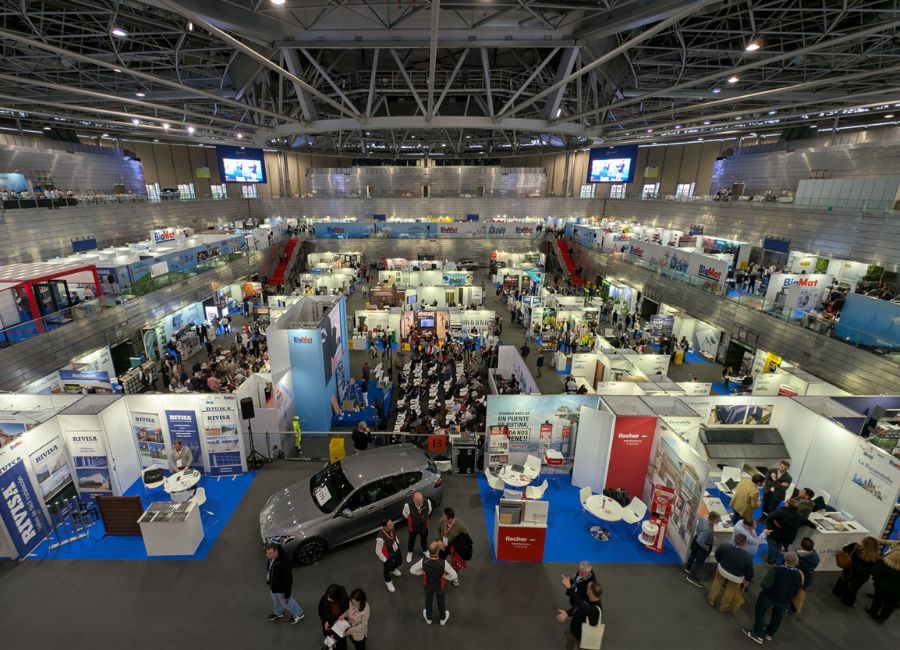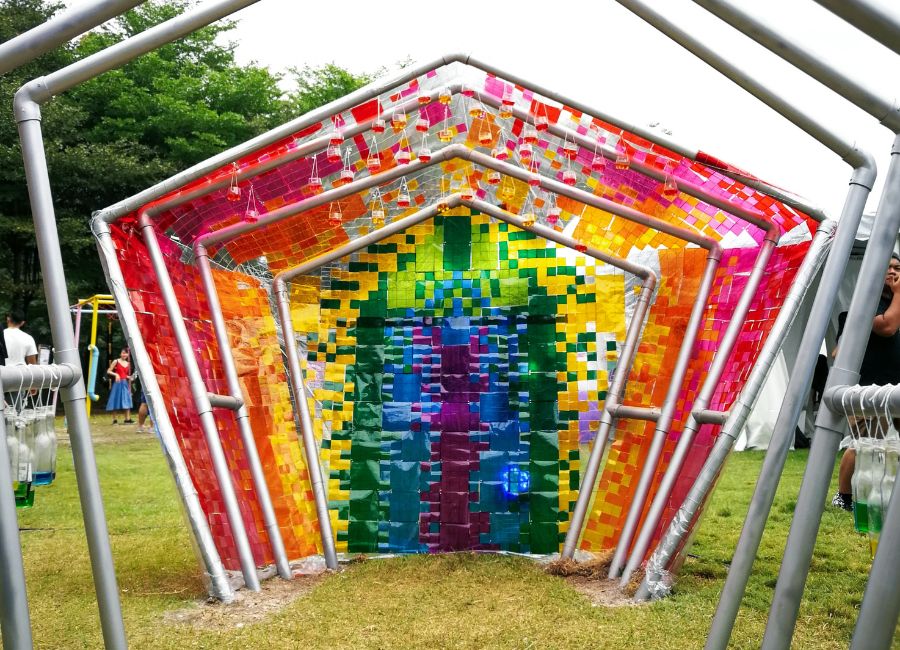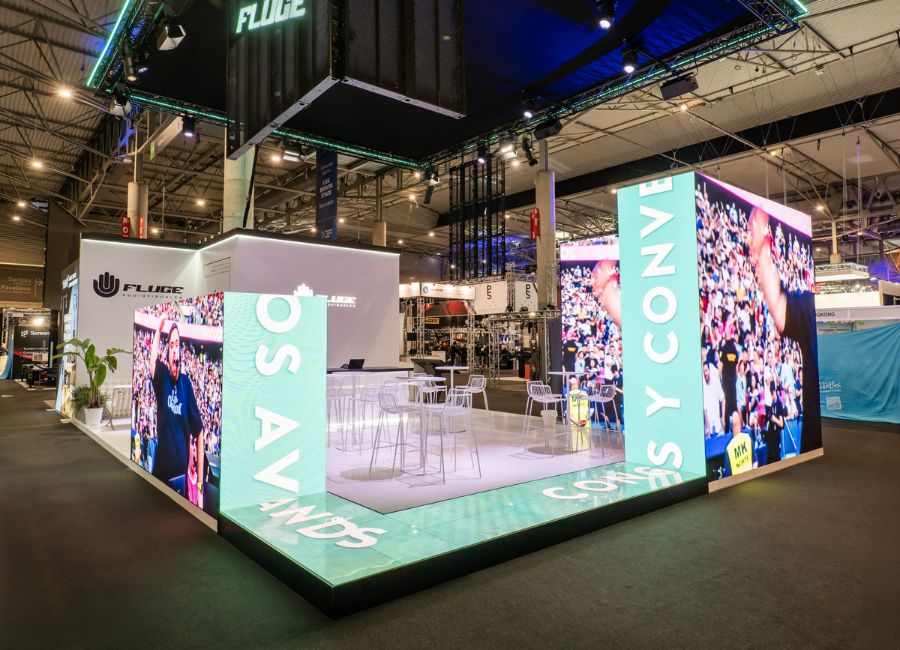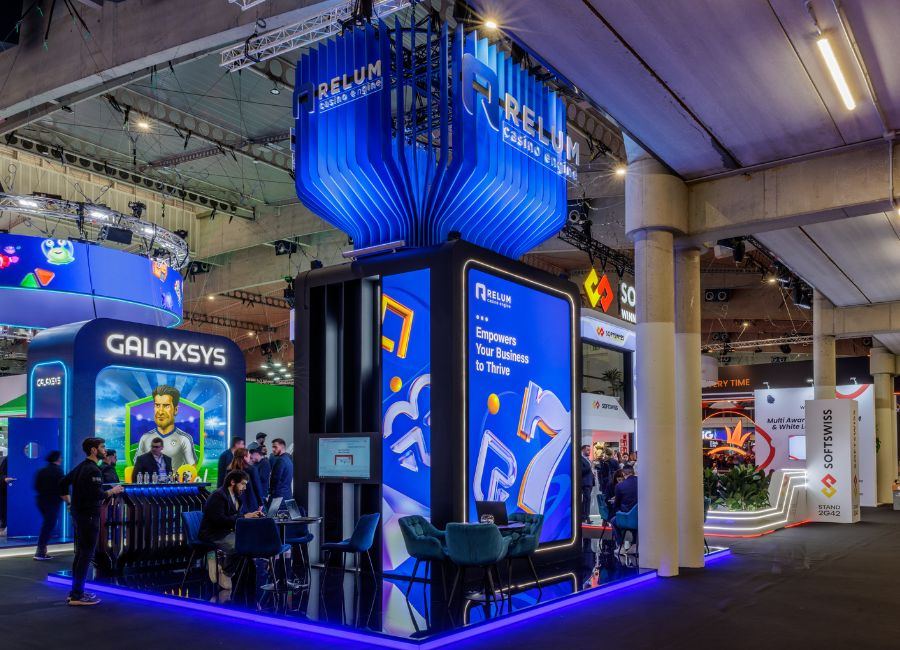In the world of experiential events, stand design plays a strategic role in brand visibility and positioning. Beyond being a simple exhibition space, a well-designed stand captures the audience's attention, reinforces corporate identity, and generates valuable business opportunities.
With the growth of trade shows, conferences, and exhibitions as key platforms for engaging with customers and business partners, companies are increasingly seeking innovative and sustainable solutions for their stand designs. The evolution of the sector has driven the integration of new technologies, eco-friendly materials, and interactive experiences—elements that help brands stand out and enhance their impact on visitors.
The Importance of Customizing Stand Design According to the Type of Event
Each event has its own characteristics, specific objectives, and a unique audience. Therefore, stand design must be tailored to these particularities to maximize its impact and meet the brand's strategic goals.
Trade Shows
The main objective of a trade show stand is to attract visitors and convert them into potential clients. These environments are highly competitive and packed with exhibitors, so the design must be distinctive to stand out above the rest.
In this case, stands need to be highly visual and conversion-oriented, which is why a unique design and the use of innovative materials, textures, and shapes are especially important.
Another effective element in these settings is active engagement: raffles, live demonstrations, and useful promotional materials draw attention and generate a steady flow of visitors.
These types of actions, combined with a commitment to innovative and immersive experiences, increase traffic to the stand and boost lead generation potential.
Location is also a key factor: being in a high-traffic area or near a featured zone within the venue (rest areas or auditoriums) significantly increases visibility.
From a technical standpoint, it is essential to design a functional and ergonomic space that includes meeting areas, hidden storage, exhibition zones, and allows for smooth circulation to facilitate direct interaction.
Finally, the brand message must be clear and direct, communicating the value proposition within seconds.

Exhibitions
At these events, stand design aims to convey an image or concept, creating a visual impact that reinforces brand identity. To attract the audience and effectively showcase ideas, the design must be original and stand out within the environment.
Beyond location—which remains a decisive factor—the use of large-format graphics, lighting that can create different ambiances, and innovative materials such as backlit textures or modular aluminum structures elevate the visitor experience.
Integrating interactive technologies, digital screens, or augmented reality systems allows for a closer connection with attendees and projects a cutting-edge, modern brand image.
Festivals and Events
In cultural or recreational festivals and events, stand design should focus on offering an immersive experience that fosters emotional interaction with the brand. The objective here is to generate visibility, engagement, and an authentic connection with the audience.
Since these are often held outdoors, the stand must be designed to stand out from any angle, withstand adverse weather conditions, and align with the spirit of the event. Powerful lighting, eye-catching structures, and vibrant colors help capture public attention from afar.
Interactive experiences, prize-based games, demos, photo zones, and sensory activations are commonly integrated. The stand’s location often depends on the brand’s role as a sponsor or partner.
Promotional giveaways, digital activations, and social spaces also play a key role in fostering brand recall and enhancing the overall brand experience.

Brand Activations
Brand activations are actions designed to promote and position a company, product, or service through experiences that create a direct connection with the audience, usually conducted in public spaces or commercial venues. In the context of stands, these activations not only increase visibility but also strengthen engagement and allow the brand to stand out in unconventional environments.
These activations enable the audience to experience the product or service in a tangible and emotional way through live demonstrations, product testing, sensory experiences, immersive activities, or interactive challenges.
Elements such as photo booths, augmented reality, brand ambassadors, raffles, social media challenges, and creative merchandising stimulate participation and help content go viral in digital environments. The success of an activation is closely tied to the quality of the experiential concept and its ability to remain memorable.
Phases of the Stand Design Process: From Concept to Assembly
The stand design process comprises the following phases:
Design
This is the initial stage, which begins after a meeting with the client to define their goals, needs, and expectations. It is a crucial phase, as essential aspects are determined at this point, such as the creative concept, materials to be used, spatial layout, and visual identity. In this first phase, it is vital to consider sustainable criteria for the stand’s development—an increasingly important aspect for brands.
It also includes the creation of sketches, 3D renders, and even virtual developments that allow the client to accurately visualize the final result before production begins. This phase requires a combination of creativity, strategic vision, and technical knowledge, particularly concerning regulations, materials, visitor flow, and functionality.
Fabrication and Construction
Once the design is approved, the fabrication and construction phase begins, where every detail is important to ensure an optimal result that remains faithful to the presented design. At this stage, materials are carefully selected, main structures are built, and modules and graphic elements are assembled. Throughout the entire process, sustainability criteria must be taken into account, prioritizing reused and/or reusable materials and structures, with certifications that guarantee sustainable sourcing (FSC/PEFC) or recycled origins.
The process begins with the production of the structural base, followed by the creation of panels, graphics, and vinyls that will define the stand's personality. It is essential to involve specialized professionals in carpentry, metalwork, graphic printing, and vinyl application, all working in coordination under a strict schedule.
In some cases where production is complex, a pre-assembly of certain components is carried out to ensure proper fit.
Assembly and Dismantling
Once the stand is fabricated, assembly takes place in the assigned exhibition space. The first step involves laying the flooring—either platform or carpet—followed by assembling structures, installing graphic elements, lighting, technological components, and verifying their proper functioning.
After the event, dismantling is performed—a process that must be fast, efficient, and safe to avoid damage and meet the timelines set by the organizers. In many cases, certain components can be reused or recycled, promoting sustainability and reducing costs for future events. This is especially relevant for modular or reusable structures designed for multiple setups.
During assembly and dismantling, particular attention must be paid to waste generated and its proper management through selective removal.
Operational Management
Beyond design and production, a fundamental part of the process is operational management: logistics, permit handling, coordination with event organizers, and technical suppliers.
During the exhibition, it is advisable to have support staff on hand to assist visitors, supervise the stand’s condition, and handle any unforeseen issues. Well-planned management ensures a smooth experience, avoids setbacks, and maximizes the brand's impact at the event.
Stand Designs: Types
There are different types of stands, and choosing the right one depends on the event’s objectives, available space, and the kind of experience the brand wants to offer visitors. Below are the main types:
Custom Stands
Also known as bespoke or "custom" stands, these are spaces designed from scratch to reflect the brand’s identity or message, aiming for high impact and alignment with the event’s strategic objectives.
They are used when unique exhibition solutions are required, or when the goal is to achieve a strong visual or media impact, stand out with a unique and creative concept, or deliver a message in an innovative way within highly competitive environments.
Unlike other formats, custom stands offer maximum creative freedom, allowing clients to incorporate unconventional structures, exclusive materials (such as natural wood finishes, technical textiles, or backlit acrylics), and cutting-edge technology: LED screens, augmented reality, touch interaction systems, and more. All of this helps create a memorable experience aligned with the brand's values.
Modular Stands
Modular stands also stand out in design, constructed using prefabricated structures, which allow for quicker and more cost-effective assembly. They generally consist of square, rectangular, or curved modular structures that can be adapted to the available space.
Within this category, premium modular stands use advanced systems such as BeMatrix-type reusable aluminum structures, popular for their versatility, contemporary look, and ease of assembly. These are an excellent choice for companies that frequently participate in trade shows and conferences.
Unlike more conventional stands, premium modular ones allow for advanced customization without sacrificing the practicality of the modular system. Thanks to their lightweight yet sturdy structure, they can be configured in multiple ways to meet the event’s needs, optimizing time and reducing long-term costs.
Both custom and modular stands align with a company’s marketing strategy and must meet not only aesthetic standards but also functional, logistical, and communicative criteria.

Most Commonly Used Materials in Stand Design and Fabrication
Material selection in stand design is a key aspect that influences not only aesthetics but also functionality, durability, and the overall sustainability of the project. Below are the most widely used materials in the industry:
- Wood: One of the most versatile and frequently used materials in stand construction, wood adapts to various styles and requirements. Its warm, natural finish helps create welcoming and sophisticated spaces—ideal for brands aiming to convey elegance, tradition, or a commitment to sustainability.Common types of wood used in stand production include MDF, particle board, plywood, laminated timber, melamine, and OSB. Its ease of handling, range of finish options, and mechanical strength make it a top choice in exhibition carpentry. Using FSC- or PEFC-certified wood ensures sustainability, as it guarantees the material comes from responsibly managed forests.
- Aluminum: Widely used in modular and reusable stands due to its lightweight nature, structural strength, and easy assembly. Its recyclability makes it a smart choice for sustainable designs.Aluminum also enables the creation of innovative structures with contemporary finishes that can be adapted to different layouts.
- Glass and Acrylics: These materials are used to create visual dividers, showcases, and backlit panels that add elegance and modernity to a stand.Glass offers transparency and sophistication, while acrylic is a lighter and more versatile alternative—ideal for creating 3D lettering, decorative elements, illuminated surfaces, and creative components without compromising durability.
- Textiles: Technical fabrics and printed textiles are used for wall coverings, banners, signage, and furniture wraps. Their flexibility, wide range of finishes, and compatibility with high-quality digital printing make them highly valuable for visual communication in stand design.
Measuring ROI on a Stand
Measuring return on investment (ROI) for a stand is essential. It helps assess whether the effort was worthwhile and informs adjustments for future events. Understanding this data supports better decision-making moving forward.
ROI is typically measured by tracking the number of visitors, sales, and qualified leads generated, as well as agreements closed during the event. Media coverage and press attendance are also relevant metrics.
Can Stand Design Be Sustainable?
Sustainability has become a core pillar in modern stand design. More and more brands are seeking to reduce their environmental footprint by adopting solutions ranging from recyclable materials to optimized logistics.
Stands are now designed with eco-efficiency in mind from the conceptual stage, incorporating:
- Reusable modular structures for multiple setups.
- LED lighting, offering low energy consumption and high durability.
- Printing techniques using eco-friendly inks.
- Zero-waste assembly systems (such as tool-free fittings or interlocking panels).
Additionally, emphasis is placed on component reuse, efficient storage, and reducing transport volume—all aimed at minimizing environmental impact and operational costs.
This approach not only benefits the planet but also enhances brand positioning, demonstrating a genuine commitment to sustainability—something increasingly valued by today’s consumers.
Technologies Shaping Stand Design
Technological innovation has completely transformed stand design, turning stands into smart, interactive, and user-centric spaces. It’s no longer just about exhibiting—it's about creating memorable experiences that connect emotionally with the audience.

Key technologies driving this transformation include:
Virtual and Augmented Reality
Virtual Reality (VR) and Augmented Reality (AR) have revolutionized how attendees interact with stands. These tools offer immersive tours, 3D product visualization, and personalized simulations, eliminating the need for bulky physical samples. Besides optimizing space and resources, these experiences enhance engagement and accelerate visitor decision-making.
Interactive Screens and Gamification
Touchscreen displays enable users to explore detailed information, compare products, or browse digital catalogs in a smooth, autonomous, and visual way.
Gamification introduces fun elements like challenges, contests, or digital rewards, encouraging active participation and extending the time visitors spend at the stand.
These strategies not only capture attention but also strengthen brand recall by creating positive and shareable experiences.
Artificial Intelligence
Artificial Intelligence (AI) adds an extra layer of personalization and efficiency to stand design. From chatbots and virtual assistants that answer real-time questions, to data analysis systems that monitor visitor behavior, AI helps optimize resources and dynamically adapt content.
This transforms the stand into an active tool for both lead generation and insights gathering, fully aligned with the client's commercial objectives.
The Role of the Stand in Marketing Strategy
A stand is not just a physical structure—it is a tangible extension of the brand. It’s an experiential marketing tool that blends design, communication, and strategy to maximize event impact.
Its presence enables:
- Attracting new customers and generating business opportunities.
- Strengthening brand positioning through a consistent and powerful visual identity.
- Creating high-value content for social media, such as videos, interviews, live streams, and attendee testimonials.
When conceived as an immersive experience, the stand allows visitors to "live the brand" fostering long-lasting emotional connections. A well-designed environment with technological resources and interactive features becomes a two-way communication channel between the brand and its audience.
Trust 4foreverything With Your Stand Design: A Strategic Partner for Unique Experiences
Designing and building stands is a process that requires expertise, vision, and flawless technical execution. To achieve real impact, it is essential to have a specialized partner that oversees every phase of the project—from concept to setup.
In this regard, 4foreverything positions itself as a strategic ally in the creation of innovative exhibition spaces, offering comprehensive solutions that include:
- Conceptual design aligned with business objectives.
- High-quality technical production.
- Efficient and flexible operational logistics and assembly.
Thanks to its personalized approach, 4foreverything tailors each project to the client’s profile and target audience, combining aesthetics, functionality, and technology to deliver a truly distinctive result.
Trust your stand design to a team of experts who understand the industry’s challenges, pay attention to every detail, and work to maximize your brand’s strategic impact.






